
The agency that oversees oil and gas drilling in the state says it doesn’t collect nearly enough money to clean up wells in case companies walk away. Regulators say the recent influx of small, private companies means Alaska risks shouldering the cost of abandoned wells. State lawmakers are receptive to addressing the issue.
Cleaning up after an oil or gas well in Alaska isn’t cheap. Normally, the company that drilled the well is responsible for plugging it up. But if the company goes bankrupt and can’t pay, the state of Alaska foots the bill. So Alaska requires companies to hand over a $100,000 to $200,000 bond before they start drilling — kind of like a security deposit.
But according to Cathy Foerster, who chairs the Alaska Oil and Gas Conservation Commission, that’s not nearly enough money.
“The bonding that operators have for well liability in the state of Alaska is woefully inadequate,” Foerster said.
Foerster estimates it can cost up to $20 million to clean up a well in Alaska, due to the remote, challenging drilling environment. Foerster said for a long time, bonding wasn’t a big issue because Alaska was dominated by huge, public oil companies — the state wasn’t worried about Exxon not having the cash to clean up wells, for example.
But new tax incentives attracted a wave of small, private oil and gas companies. That’s when Foerster started to get nervous.
“It’s a whole different playing field,” Foerster said. “We have little companies that we don’t know what their capability for liability coverage is and when they might just disappear in the night.”
Last year, two companies operating in Alaska — Aurora Gas and Linc Energy — went bankrupt. According to state data, there are currently 33 wells owned by Linc and Aurora that state inspectors haven’t yet confirmed are properly plugged and abandoned. Some of the 33 wells are still producing, but they need to be cleaned up at some point.
Foerster said if bankrupt companies can’t pay for cleanup and the bond doesn’t cover the cost, Alaska ends up paying.
“So we’re leaving the citizens of Alaska with the liability to clean up all these messes if we don’t get a bigger bond,” Foerster said.
This week, Foerster is in Juneau to talk to lawmakers. Anchorage Democrat Andy Josephson, who co-chairs the House Resources Committee, was alarmed when he heard what Foerster had to say.
“It’s not enough — the bonds are not enough,” Josephson said. “And I’m sort of amazed that we would set up a system where companies could either walk away from a lease or declare bankruptcy and we’re left holding the bag.”
The Oil and Gas Conservation Commission doesn’t need a new law to raise the bond amount. But Josephson said lawmakers might consider adding language in the recently introduced oil and gas tax bill, House Bill 111, to address the issue. Republican Senator Cathy Giessel, who chairs the Senate Resources Committee, also heard from Foerster this week.
“Her concern is probably a justifiable one — $200,000 isn’t a lot,” Giessel said.
Giessel says she’s not sure the legislature needs to get involved. The senator said she will rely on the Oil and Gas Conservation Commission’s experts to take the lead on the issue.
Kara Moriarty, who advocates for industry as head of the Alaska Oil and Gas Association, said she wasn’t surprised the issue came up and that the industry is willing to discuss a fix. But Moriarty wants to make sure the bond amount doesn’t become a barrier.
“We need to make sure that…it does not prevent a smaller company from entering the market or being dissuaded from investing in Alaska,” Moriarty said.
Foerster said she’s not sure how much more companies should pay in bonds. She suggested it’s possible it could be flexible depending on the company and the project.
But she’s certain something needs to change.
Elizabeth Harball is a reporter with Alaska's Energy Desk, covering Alaska’s oil and gas industry and environmental policy. She is a contributor to the Energy Desk’s Midnight Oil podcast series. Before moving to Alaska in 2016, Harball worked at E&E News in Washington, D.C., where she covered federal and state climate change policy. Originally from Kalispell, Montana, Harball is a graduate of Columbia University Graduate School of Journalism.




